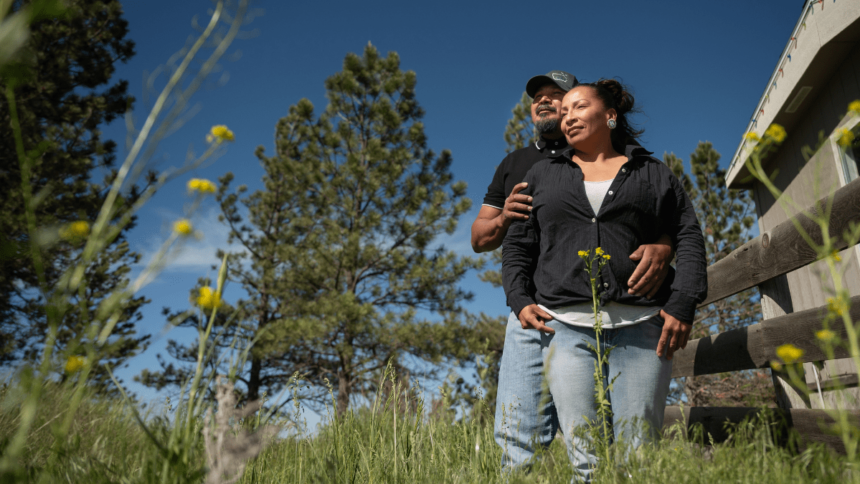Crystal Hiwalker ponders whether her heart and lungs would have continued functioning if the ambulance crew could have administered a transfusion while she was losing blood during a stormy, 100-mile journey.
Due to a snowstorm in 2019, it took 2.5 hours to travel from her small town of Lame Deer to the advanced trauma center in Billings.
Doctors at the Billings Clinic hospital successfully resuscitated Hiwalker and stopped the bleeding from her ruptured ectopic pregnancy. They were amazed not only by her survival despite her heart stopping and nearly complete blood loss, but also by her recovery without any brain damage.
Subsequently, the Montana State Trauma Care Committee realized that the ambulance carrying Hiwalker had passed by two hospitals with blood supplies. This led the committee members to question what could have happened if Hiwalker had access to that blood on her way to Billings.
This realization inspired the committee members to establish the Montana Interfacility Blood Network, which they claim is the first program of its kind in the United States. This network enables ambulance crews to collect blood from hospitals and administer transfusions to patients en route to the advanced care they require.
“We came up with the concept of a blood handoff — similar to a drive-thru at a fast-food restaurant — where blood could be picked up on the way,” explained Gordon Riha, a trauma surgeon at the Billings Clinic trauma center where Hiwalker received treatment. Riha emphasized that timely blood transfusions can prevent death or permanent brain damage.
The network primarily targets rural patients, who face higher rates of traumatic injuries and fatalities, stated Alyssa Johnson, the trauma system manager for the state of Montana.
“We need to think outside the box. We don’t have easy access to blood banks or Level 1 trauma centers everywhere,” Johnson added.
Leaders of the network reported that the program has already assisted at least three patients since its inception in 2022. They are optimistic about its future utilization.
Hiwalker expressed enthusiasm about the program, stating, “I’m thrilled that something like this was initiated, as it could save many lives in my community.”
“We have to get more creative. We don’t have a blood bank on every corner, and we don’t have a Level 1 trauma center on every corner.”
Alyssa Johnson, trauma system manager for the state of Montana
Hiwalker mentioned incidents she had heard of in her rural community where individuals bled to death following car accidents, gunshot wounds, and stabbings. Johnson added that serious bleeding can result from work-related injuries, cancer, gastrointestinal issues, and childbirth.
After Hiwalker’s close call with death, the Montana trauma committee began discussing the blood network. They initially created a map of 48 facilities with blood banks and subsequently established guidelines for communication, packaging, transportation, documentation, and billing related to blood among hospitals, blood banks, ambulances, and laboratories.
The network is only activated during emergencies, which means there is no time to conduct blood type tests on patients. Hence, the network uses only type O red blood cells, which are safe for transfusion in most patients.
The receiving hospital, not the one that provided the blood, is responsible for billing the patients’ insurance for the blood. Sadie Arnold, who manages the blood bank at Billings Clinic, mentioned that the cost of blood transfusions varies based on the amount of blood needed but typically ranges from several hundred dollars to over a thousand.
Arnold emphasized the importance of proper storage and management of blood by qualified professionals with specific qualifications and certifications. Some rural hospitals may lack the necessary space or resources for a lab, making it challenging to store blood products that can expire and are in high demand, especially during a national blood shortage.
If rural hospitals do store blood, they may have limited quantities available. A rural Montanan with severe bleeding experienced this firsthand when he visited the nearest hospital, which only had one unit of type O blood, as detailed in a report on the blood network. Thanks to the new program, ambulance medics picked up additional blood from a hospital midway through an 80-mile journey to the trauma hospital.
While medical helicopters or airplanes equipped for transfusions would be ideal for transporting rural patients with severe bleeding, adverse weather conditions can make flying impossible, as in Hiwalker’s case. This can result in long ambulance rides, as some towns in northeastern Montana are over 250 miles away from the nearest advanced trauma center.
“This was truly designed for kind of that last-ditch effort,” Johnson stated. When “we’re out of options, we’ve got to get the patient moving towards a larger center, and we can’t fly.”
Johnson mentioned that the blood handoff may involve the ambulance stopping at the second hospital. However, she recounted an incident where a police officer picked up the blood and delivered it to the ambulance at a highway exit.
Ambulances may also pick up a paramedic or nurse to administer the transfusion en route, as many rural ambulance crews are staffed by emergency medical technicians who are not authorized to perform transfusions in Montana.
Cohn noted that medics in various cities and states, including those with rural areas, have begun conducting blood transfusions in ambulances and helicopters. She mentioned researchers’ interest in exploring frozen and freeze-dried blood products, which could be beneficial for rural areas due to their ease of storage and longer shelf life.
Johnson highlighted that the Montana Interfacility Blood Network is the only program specifically aimed at rural patients involving ambulances picking up blood from hospitals along their routes. She indicated that the network is garnering attention from other states with large rural regions, such as Oregon.
Hiwalker believes that receiving a blood transfusion in the ambulance could have prevented her near-death experience and the trauma her husband endured while witnessing her suffering during the ambulance ride. She expressed gratitude that her ordeal led to an innovation benefiting others.
LATEST STORIES
Reported birth of rare white buffalo calf in Yellowstone National Park fulfills Lakota prophecy
The reported birth of a rare white buffalo in Yellowstone National Park fulfills a Lakota prophecy that portends better times, according to members of the American Indian tribe who cautioned that it’s also a signal that more must be done to protect the earth and its animals.
Can Dems keep winning in Indian Country?
Tribal communities have for decades been an essential part of the voter base that gives Montana Democrats the ability to make competitive bids for statewide office. A close look at turnout figures for June 4 party primaries in the state’s eight majority-Native districts, however, indicates there may be cracks in that coalition.
By the Numbers: special session edition
Three distinct calls for special sessions of the Montana Legislature have been voted down in mail polls, per results announced by the Montana secretary of state.





